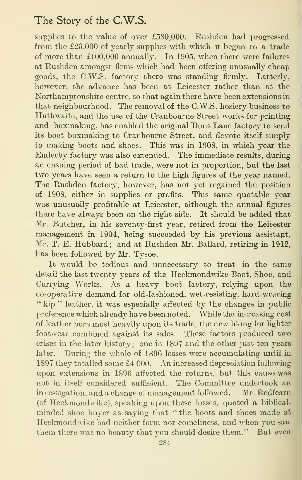Page 360 - The_story_of_the_C._W._S._The_jubilee_history_of_the_cooperative_wholesale_society,_limited._1863-1913_(IA_storyofcwsjubill00redf) (1)_Neat
P. 360
The Story of the C.W.S.
supplies to the value of over £580,000. Rushden had progressed
from the £20,000 of yearly suppHes \\dth which it began to a trade
of more than £100,000 amiually. In 1905, when there were failures
at Rushden amongst firms which had been offering unusually' cheap
goods, the C.W.S. factory there was standmg fii-mly. Latterly,
however, the advance has been at Leicester rather than at the
Northamptonshire centre, so that again there have been extensions in
that neighbourhood. The removal of the C.W.S. hosiery business to
Huthwaite, and the use of the Cranbourne Street works for printing
and boxmaking, has enabled the original Duns Lane factory to send
its boot boxmaking to Cranbourne Street, and devote itself simply
to making boots and shoes. This was in 1908, in which year the
Enderby factory was also extended. The immediate results, during
an ensuing period of bad trade, were not in proportion, but the last
two years have seen a return to the high figures of the year named.
The Rushden factory, however, has not yet regained the position
of 1908, either in suppUes or profits. This same quotable year
was unusuall}' profitable at Leicester, although the annual figures
there have always been on the right side. It should be added that
Mr. Butcher, in his seventy-first year, retired from the Leicester
management in 1904, being succeeded by his previous assistant,
I\Ir. T. E. Hubbard; and at Rushden Mr. Ballard, retiring in 1912,
has been followed by Mr. Tysoe.
It would be tedious and unnecessary to treat in the same
detail the last twenty years of the Heckmondwike Boot, Shoe, and
Currying Works. As a heavy boot factory, relying upon the
co-operative demand for old-fashioned, wet-resisting, hard-wearing
" kip " leather, it was especially affected by the changes in pubhc
preference which already have been noted. While the increasing cost
of leather bore most heavily upon its trade, the new Uking for lighter
footwear combined against its sales. These factors produced two
crises in the later history; one in 1897 and the other just ten years
later. During the whole of 1896 losses were accumulating until in
1897 they totalled some £4,000. An increased depreciation following
upon extensions in 1896 affected the returns, but this cause was
not in itself considered sufficient. The Committee undertook an
investigation, and a change of management followed. Mr. Redfearn
(of Heckmondwike), speaking upon these losses, quoted a bibUcal-
minded shoe buyer as saying that " the boots and shoes made at
Heckmondwike had neither form nor comehness, and when j'-ou saw
them there was no beauty that you should desire them." But even
284

